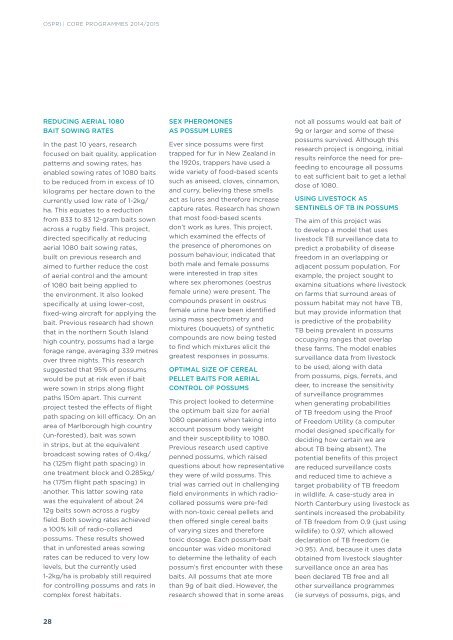Create successful ePaper yourself
Turn your PDF publications into a flip-book with our unique Google optimized e-Paper software.
OSPRI | CORE PROGRAMMES <strong>2014</strong>/<strong>2015</strong><br />
REDUCING AERIAL 1080<br />
BAIT SOWING RATES<br />
In the past 10 years, research<br />
focused on bait quality, application<br />
patterns and sowing rates, has<br />
enabled sowing rates of 1080 baits<br />
to be reduced from in excess of 10<br />
kilograms per hectare down to the<br />
currently used low rate of 1-2kg/<br />
ha. This equates to a reduction<br />
from 833 to 83 12-gram baits sown<br />
across a rugby field. This project,<br />
directed specifically at reducing<br />
aerial 1080 bait sowing rates,<br />
built on previous research and<br />
aimed to further reduce the cost<br />
of aerial control and the amount<br />
of 1080 bait being applied to<br />
the environment. It also looked<br />
specifically at using lower-cost,<br />
fixed-wing aircraft for applying the<br />
bait. Previous research had shown<br />
that in the northern South Island<br />
high country, possums had a large<br />
forage range, averaging 339 metres<br />
over three nights. This research<br />
suggested that 95% of possums<br />
would be put at risk even if bait<br />
were sown in strips along flight<br />
paths 150m apart. This current<br />
project tested the effects of flight<br />
path spacing on kill efficacy. On an<br />
area of Marlborough high country<br />
(un-forested), bait was sown<br />
in strips, but at the equivalent<br />
broadcast sowing rates of 0.4kg/<br />
ha (125m flight path spacing) in<br />
one treatment block and 0.285kg/<br />
ha (175m flight path spacing) in<br />
another. This latter sowing rate<br />
was the equivalent of about 24<br />
12g baits sown across a rugby<br />
field. Both sowing rates achieved<br />
a 100% kill of radio-collared<br />
possums. These results showed<br />
that in unforested areas sowing<br />
rates can be reduced to very low<br />
levels, but the currently used<br />
1-2kg/ha is probably still required<br />
for controlling possums and rats in<br />
complex forest habitats.<br />
SEX PHEROMONES<br />
AS POSSUM LURES<br />
Ever since possums were first<br />
trapped for fur in New Zealand in<br />
the 1920s, trappers have used a<br />
wide variety of food-based scents<br />
such as aniseed, cloves, cinnamon,<br />
and curry, believing these smells<br />
act as lures and therefore increase<br />
capture rates. Research has shown<br />
that most food-based scents<br />
don’t work as lures. This project,<br />
which examined the effects of<br />
the presence of pheromones on<br />
possum behaviour, indicated that<br />
both male and female possums<br />
were interested in trap sites<br />
where sex pheromones (oestrus<br />
female urine) were present. The<br />
compounds present in oestrus<br />
female urine have been identified<br />
using mass spectrometry and<br />
mixtures (bouquets) of synthetic<br />
compounds are now being tested<br />
to find which mixtures elicit the<br />
greatest responses in possums.<br />
OPTIMAL SIZE OF CEREAL<br />
PELLET BAITS FOR AERIAL<br />
CONTROL OF POSSUMS<br />
This project looked to determine<br />
the optimum bait size for aerial<br />
1080 operations when taking into<br />
account possum body weight<br />
and their susceptibility to 1080.<br />
Previous research used captive<br />
penned possums, which raised<br />
questions about how representative<br />
they were of wild possums. This<br />
trial was carried out in challenging<br />
field environments in which radiocollared<br />
possums were pre-fed<br />
with non-toxic cereal pellets and<br />
then offered single cereal baits<br />
of varying sizes and therefore<br />
toxic dosage. Each possum-bait<br />
encounter was video monitored<br />
to determine the lethality of each<br />
possum’s first encounter with these<br />
baits. All possums that ate more<br />
than 9g of bait died. However, the<br />
research showed that in some areas<br />
not all possums would eat bait of<br />
9g or larger and some of these<br />
possums survived. Although this<br />
research project is ongoing, initial<br />
results reinforce the need for prefeeding<br />
to encourage all possums<br />
to eat sufficient bait to get a lethal<br />
dose of 1080.<br />
USING LIVESTOCK AS<br />
SENTINELS OF TB IN POSSUMS<br />
The aim of this project was<br />
to develop a model that uses<br />
livestock TB surveillance data to<br />
predict a probability of disease<br />
freedom in an overlapping or<br />
adjacent possum population. For<br />
example, the project sought to<br />
examine situations where livestock<br />
on farms that surround areas of<br />
possum habitat may not have TB,<br />
but may provide information that<br />
is predictive of the probability<br />
TB being prevalent in possums<br />
occupying ranges that overlap<br />
these farms. The model enables<br />
surveillance data from livestock<br />
to be used, along with data<br />
from possums, pigs, ferrets, and<br />
deer, to increase the sensitivity<br />
of surveillance programmes<br />
when generating probabilities<br />
of TB freedom using the Proof<br />
of Freedom Utility (a computer<br />
model designed specifically for<br />
deciding how certain we are<br />
about TB being absent). The<br />
potential benefits of this project<br />
are reduced surveillance costs<br />
and reduced time to achieve a<br />
target probability of TB freedom<br />
in wildlife. A case-study area in<br />
North Canterbury using livestock as<br />
sentinels increased the probability<br />
of TB freedom from 0.9 (just using<br />
wildlife) to 0.97, which allowed<br />
declaration of TB freedom (ie<br />
>0.95). And, because it uses data<br />
obtained from livestock slaughter<br />
surveillance once an area has<br />
been declared TB free and all<br />
other surveillance programmes<br />
(ie surveys of possums, pigs, and<br />
28


